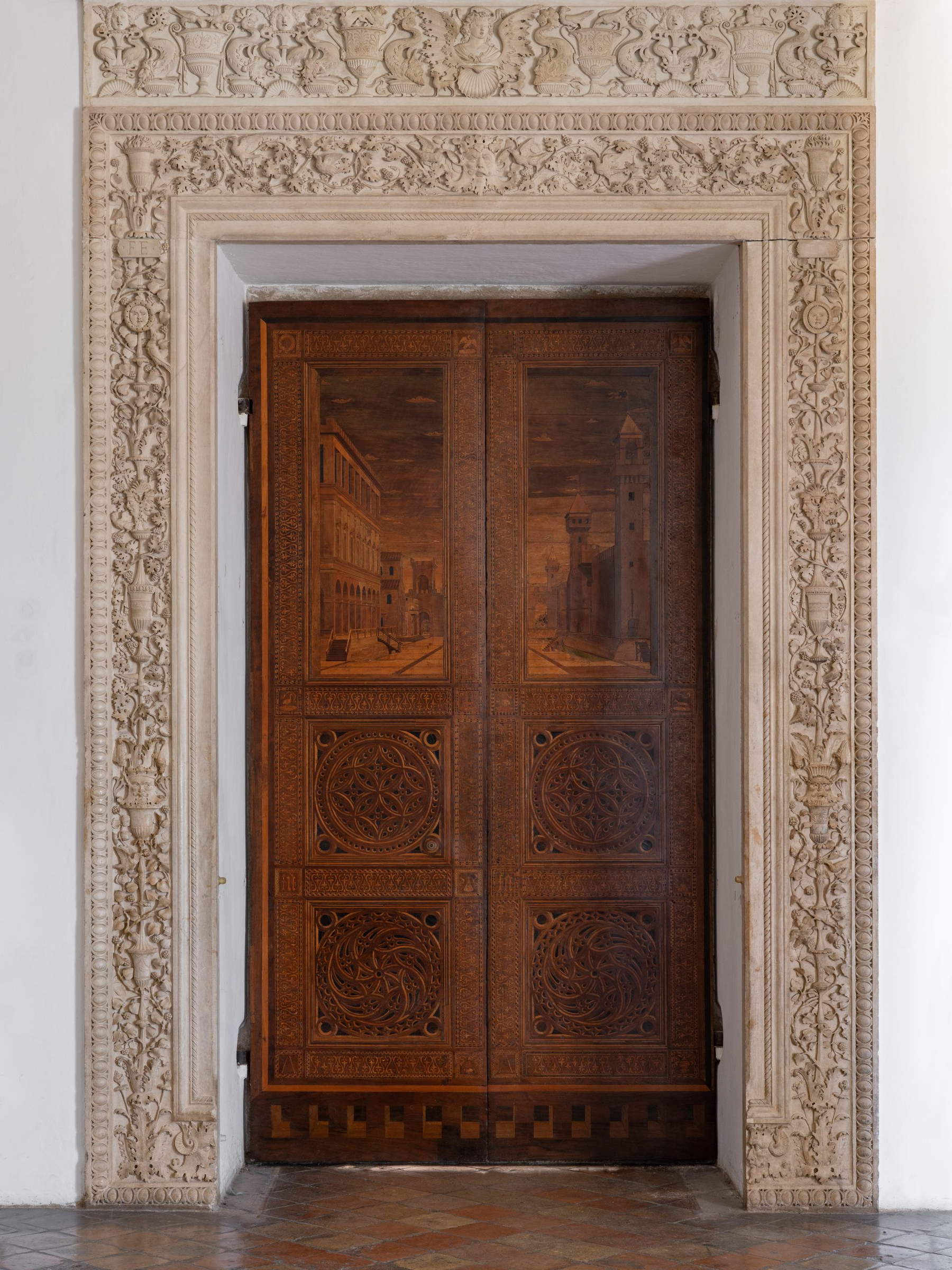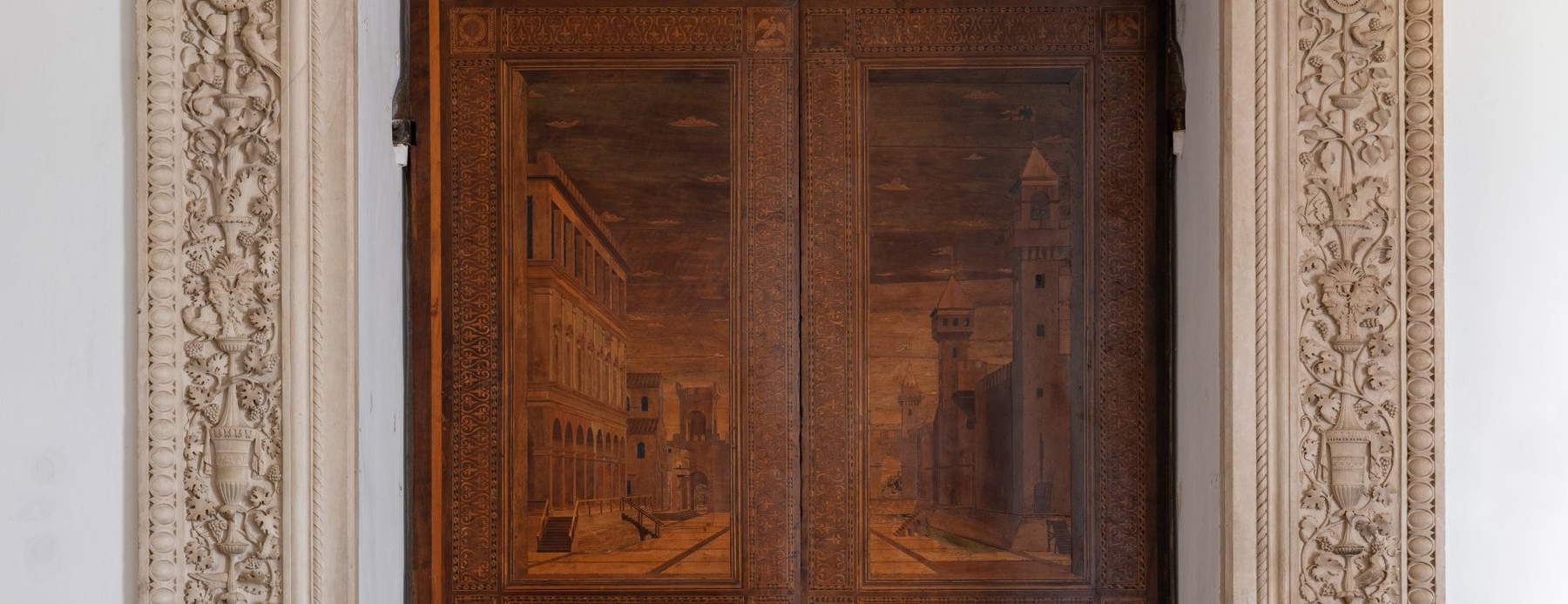The Ducal Palace of Urbino will reopen to the public on Dec. 18 the apartment of the Duchess, also known as the apartment of the Magnifico, located on the piano nobile. The opening marks the conclusion of the penultimate restoration work financed with PNRR funds, which involved the sala delle Veglie and the building body of the ancient Castellare di Urbino. The rooms, traditionally identified as the Duchess’s apartment, were inhabited by the duchesses of the Della Rovere family between 1508 and 1631, together with their courts. In historical documents they are also remembered as the apartment “of the Magnificent,” since between 1502 and 1512 Giuliano de’ Medici, son of Lorenzo the Magnificent, stayed there during his exile from Florence. His long stay with Guidubaldo I and Francesco Maria I inspired Baldassarre Castiglione, who included it among the protagonists of his famous Book of the Courtier.
The Hall of the Vigils, which after the new museographic layout will house the entire artistic career of Giovanni Santi, painter, poet and set designer, as well as father of Raphael, takes its name from the convivial gatherings that took place at the court of Guidubaldo da Montefeltro and Elisabetta Gonzaga. These gatherings were held from evening until dawn and brought together ladies and knights on an equal footing, intent on discussing poetry, literature and philosophy, listening to music and dancing according to the fashions of the time. It was Castiglione himself, who lived at court between 1504 and 1513, who immortalized in unforgettable pages that cultured and brilliant atmosphere that made Urbino a center of attraction for young artists and intellectuals, eager to learn the art of the perfect courtier.
Cleaning and restoration work has restored full legibility to the refined stone carvings and decorative stuccoes that embellish these rooms. After the departure of Luciano Laurana in 1472, the task of continuing the work passed to the Sienese architect Francesco di Giorgio Martini, who designed the famous helicoidal ramp and covered the four rooms of the Castellare with elegant pavilion vaults, recovering an architectural model of classical origin reinterpreted with great originality. He entrusted the Milanese sculptor Ambrogio Barocci with the execution of the stuccoes of the vaults, marking an early rediscovery of an ancient-derived decorative technique that was faster and cheaper than those previously used in the palace.

The stuccoes of the antechamber are unique for the ingenious invention of small angels who, suspended in an open sky above the pavilion, play and dance amid festoons of fruit moved by the wind. The decoration of the vault was completed after September 1482, as evidenced by the coats of arms at the corners of the vault bearing the initials of Federico da Montefeltro (FE DVX) and his heir Guidubaldo (GVI DVX). Barocci’s work, also visible in the portals and fireplaces, has made it possible to reevaluate the roots of Urbino’s sculptural tradition and the formation of a local school of sculptors, active until the 17th century, whose greatest exponent was Federico Brandani. By the latter, alongside the famous Aquilini ceiling (made readable again after the restoration of the reassembly carried out by Diomede Catalucci in 1919), some fragments of the vault of the roveresco hall on the second floor, detached in 1846 and then preserved in the hall itself, which later became the courtroom of the Tribunal, now return to be exhibited after about a century and restored for the occasion.
The centerpiece of the new display in the Duchess’s drawing room is Raphael Sanzio, whose genius the Galleria Nazionale delle Marche celebrates through masterpieces that entered its collections during the 20th century. Prominent among them are the tapestries of the Acts of the Apostles, inspired by cartoons for the Sistine Chapel, the small St. Catherine of Alexandria, once the wing of a devotional triptych, and the celebrated Portrait of a Gentlewoman (La Muta). These works testify to Raphael’s artistic journey, marked by his dialogue with Perugino, Pinturicchio and Leonardo da Vinci between Perugia and Florence in the early 16th century. Also on display are works by Timoteo Viti and Girolamo Genga, artists of different backgrounds but who share deep ties with Urbino and significant interweavings with Raphael’s experience. In particular, Timoteo Viti’s splendid stained-glass window in the church of Santa Maria della Torre, recently restored by the Opificio delle Pietre Dure in Florence, will be on view with new lighting.
Finally, in the Duchess’s bedroom will be relocated the original tapestries that decorated the Ducal Palace in the second half of the 16th century. The six artifacts, four of which are intact and two fragmentary, share the theme of nature, populated by real and fantastic animals, such as unicorns and griffins, moving through wooded landscapes. The Della Rovere dukes, like many other Italian and European courts, loved to adorn the halls of their palaces with precious textiles at festivals and solemn ceremonies. These tapestries, true scenic backdrops that lined the walls from floor to ceiling, created immersive, fairy-tale environments capable of transporting guests to natural and imaginary worlds, an experience that visitors will once again be able to enjoy thanks to the new display.
 |
| Urbino's Ducal Palace reopens Duchess' apartment to visitors |
Warning: the translation into English of the original Italian article was created using automatic tools. We undertake to review all articles, but we do not guarantee the total absence of inaccuracies in the translation due to the program. You can find the original by clicking on the ITA button. If you find any mistake,please contact us.